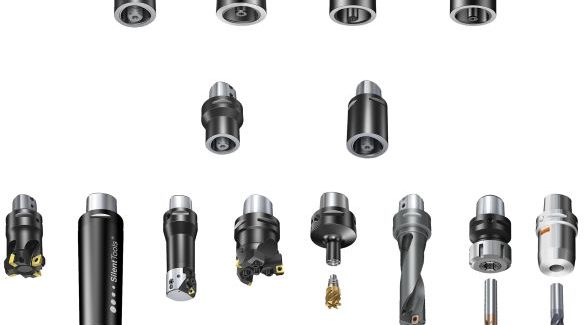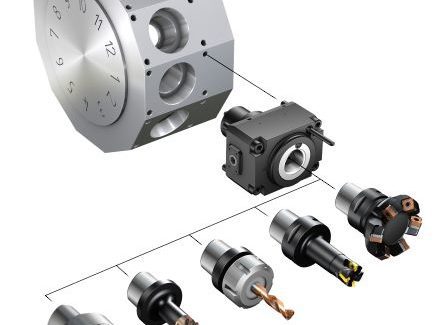Six Benefits to Modular Tooling Solutions
Using modular tool-holding accessories can help you accelerate your efficiency and increase flexibility in your machine shop.
Posted: September 12, 2021
METAL CUTTING COLUMN
By Brent Godfrey
Modular cutting tool accessories can be highly advantageous for manufacturers looking to tool-up machines. Instead of spending money on separate tooling attachments for each component and feature, modular tooling solutions allow machine shops to build optimized tooling assemblies for many applications using just a small inventory of standard items.
With modular quick-change tooling on the turret, setup times are decreased and metal cutting tasks are completed more efficiently. And, if the cutting tools wear out or if a new work order needs to be configured, replacement cutting tools can be quickly prepped or exchanged for alternates with minimal downtime.
The modularity is derived from a common connection design style. A modular coupling’s shape should provide stability, strength, non-slip transmission of torque and resistance to bending while in use, while also being relatively easy to exchange for another piece.
For tooling that requires different gauge lengths, modular extensions can be quickly added or removed, and, thanks to a strong, precise clamping, the tool retains its rigidity and accuracy for all its cutting tasks. The versatility of cutting-tool assemblies and their ability to interchangeably attach to the tool-holding interface, are the core of a modular tooling solution.
KEY BENEFITS
Understanding the key benefits can help you make the business case for adding a modular cutting tool system to your machine shop.
1. Fast changeouts
For traditional cutting tools attached by a square shank tool, a changeout may take as long as two minutes, including measuring to ensure the correct insert position. A quick-change modular cutting tool-holder accessory offers much faster changeouts — sometimes as quick as 20 seconds with the half-turn of a clamp. That time savings adds up over the course of a day or week and equals large gains in production — up to a 25 percent productivity increase according to Sandvik Coromant research.
2. High repeatability
Accurate tooling solutions should always be a top priority, and a quick-change tooling system shouldn’t sacrifice accuracy and repeatability. By design, some modular cutting tool systems offer precision tool clamping, and are often capable of repeating a setting placement within 2 microns. For example, Sandvik Coromant uses a tapered polygon-shaped coupling that achieves both face and taper contact — a style the company introduced in 1990 for its still-in-use Coromant Capto® tooling system. This promise of accuracy allows you to get back to work quicker and immediately continue with production.
3. Versatility in tooling
Between the options in cutting tools, holder extensions and the number of machine adapters, you can load on the tool-holder assembly, modular cutting tool platforms offer a wide range of tooling task options. This capability to mix and match while maintaining the rigidity of the tool makes it worth adopting a modular tooling strategy. With this versatility, you can take on more jobs and complete them faster through greater machine uptime.
4. Quick ROI
Another critical benefit to modular cutting tools is their relatively quick ROI. With the time savings and increase in production capability through quick change, modular cutting tools, the investment in the system can be earned back quickly — often in a few months.
5. Shop flexibility
With a modular cutting tool platform tool in your shop, you gain a great deal of flexibility. Your sales team can confidently bid on almost any project because of the added capabilities that modular cutting tools add for performing almost any tooling task. You will also be able to better utilize staff because training time for tool set up and changeover can be reduced using a modular tool system.
6. Predictive maintenance
Digitalization is becoming more widely accepted in today’s machine tools. With new technology, such as digital capabilities in driven tool holders, modular tool systems can create money-saving opportunities through predictive maintenance and use analysis. With this technology, an app allows you to monitor the tool’s operation and search for faults, thereby allowing you to run the system longer, more efficiently and perform maintenance only as necessary.
KEY CONSIDERATIONS
When selecting a modular cutting tool system, start with the question: “How will this benefit my business?” In most cases, the impact will be positive — faster manufacturing, more efficient time use, better end products and a quick ROI. The real decision comes in determining which modular tooling solution is best for your shop. There are several factors to consider and it’s important to look at the following questions:
- How long has the provider offered modular cutting tools? The more years of experience, the better. Sandvik Coromant, for example, has 75-plus years of experience providing machinists with shop-proven modular cutting tools.
- How many cutting tool designs are available for your system? The best manufacturers have thousands of cutting tool designs to meet your exacting specifications for any given project.
- What is your precision threshold? If the modular tool holder can’t provide reclamping precision up to 2 microns, you should look elsewhere.
- How deep is the product inventory? One advantage of a modular tool system is that long lead times for custom (and expensive) tool holders are eliminated by using standard products and connectors. This makes it easier to get parts when needed. A cutting tool manufacturer should be able provide availability and a steady supply of tools to avoid any downtime in the shop.
- What’s coming next in modular cutting tool accessories? Consider whether the manufacturer offers new technology capabilities that can help improve shop production through digital transformation, automation and condition monitoring.
When you are satisfied with answers to these questions, you know you have found the right system and provider, and you are ready to truly explore the benefits of using a modular cutting tool platform.
Brent Godfrey is a machine integration product specialist at Sandvik Coromant. Learn more at www.sandvik.coromant.com/en-us/products/coromant_capto.






